Battle of Abyssinia
The Abyssinian command did not allow the enemy to complete the training and move to a new offensive. The Abyssinians correctly took into account that the forces of the Italian army were stretched out and not ready for an offensive, since the divisions to strengthen the Northern Front are still on the way and the rear is not rebuilt. The northern Italian front at that time numbered about 250 thousand people - 12 divisions (regular 5, fascist 5 and colonial 2). If the Abyssinian troops managed to strike the Italian army, detached from the main bases in Eritrea and had not yet had time to prepare the roads and rear in the occupied territory, in the direction of the least secured right flank, pinning the enemy on other directions and activating the partisans on enemy communications, the Italians would have very hard. If the Italian army had been confronted by an army of equal potential, the case could have ended in complete defeat.
Thus, the beginning of the war revealed many shortcomings in the Italian army: there was a lack of equipment, despite the extensive work on organizing the rear, the troops were poorly supplied; marauding and black market flourished; army units and fascist militia vied with each other, which adversely affected the overall combat capability.
Abyssinian troops were concentrated in three groups totaling 150-200 thousand soldiers. The first group of the Ras Mouluget (Ethiopian War Minister) was located opposite McAlle; against the center of the Italian army - the troops of the races Kas and Seiyoum; against the right-wing stewards of the Italians, the races of Imru and Aiel. Behind the right wing, the Abyssinian reserve was concentrated — the guard, designed to reinforce this wing or center. The offensive of the Abyssinian army was due to the fact that further retreat could lead to the loss of large spaces and the demoralization of troops.
However, a powerful simultaneous strike could not be organized. First, in December, the troops of the princes Imru and Aielu went against the right wing of the Italian army in the direction of Aksum. Abyssinians forced the river Takkaze and created a serious threat to the Italian flank. At one of the sites, the colonial battalion was destroyed, which simultaneously attacked from the front and rear, the Abyssinian warriors took many trophies as trophies. weapons. During these battles, the Abyssinians were able to damage and disable several tanks the enemy. The Italians, to restrain the onslaught of the enemy, transferred reserves to this flank. After this there was a relative lull, small clashes in this direction continued until mid-January 1936. During these battles, the Italians first used chemical weapons (mustard bombs). Italy violated the 1925 Geneva Convention. Emperor Haile Selassie subsequently wrote: “We attacked the enemy’s machine gun nests, his artillery, grabbed his tanks with our bare hands, we carried out aerial bombardments, but we could not do anything against the poisonous gases that quietly dropped on our faces and hands.”
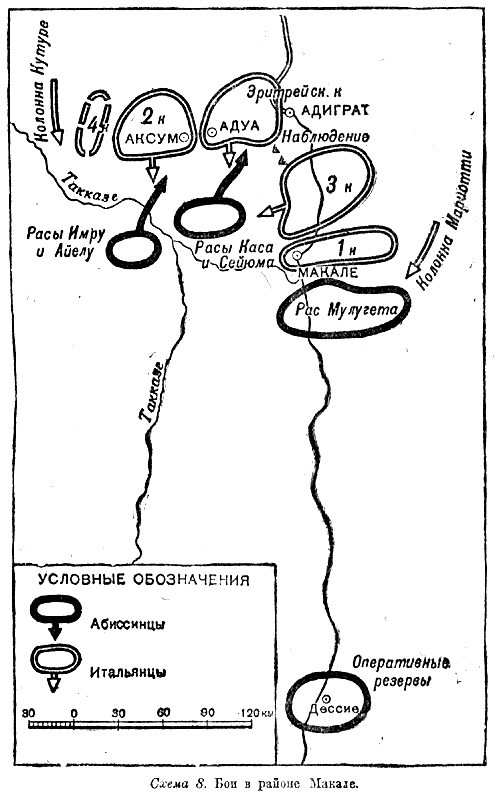
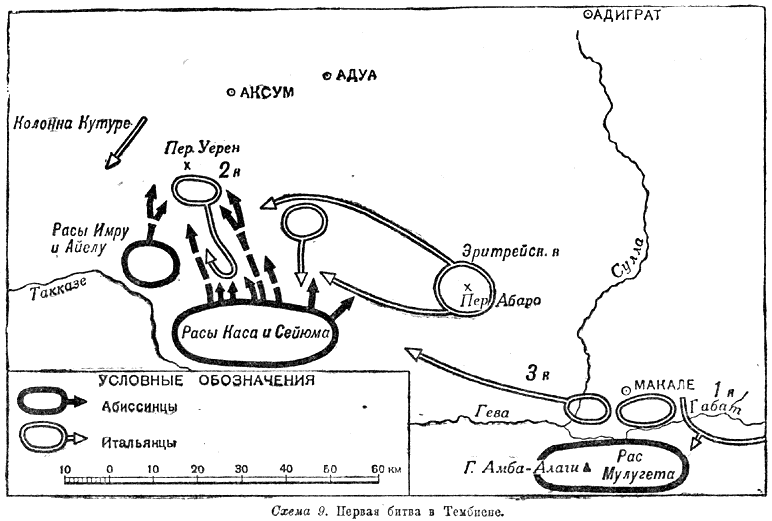
Map Source: Korsun N. The Italo-Abyssinian War 1935-1936
Almost a month after the first attack of the left wing of the Abyssinian army, the forces of the races Kas and Seiyoum went to the offensive in the center of the Abyssinian military formations. Ras Seyouma vowed to "win or die." The Italians, knowledgeable about the plans of the enemy, were ready. The Eritrean (colonial) corps received orders to retreat, dragging the enemy along. Then he had to stop and go to the counteroffensive, while simultaneously attacking the flanks of the Abyssinian army the 2 corps — on the left flank and the 3 corps — on the right. At the same time, the 1 Army Corps was supposed to forge the army of the Muluheta race in the area of Makalla.
Ethiopian troops launched an offensive and broke through the enemy defenses. They almost went to the road Adua - Makalle. 18-19 January 1936 The position of the Italian troops in this sector of the front was critical. But on January 20-21, having received reinforcements in manpower and equipment, the Italian troops launched a counteroffensive. They delivered a powerful blow to the Ethiopian troops, and again used poisonous substances. The Italians tried to surround the enemy in the area of the river Takkase in the area of Tembien. Abyssinians, showing great persistence, suffered great losses, but for two days they fought with the enemy. The 3 Italian Corps could not complete the maneuver north of r. Geva, which allowed the Abyssinian troops to escape from the outlined ring environment. The troops of the races Kas and Seyum retreated. Their withdrawal forced the retreat to begin with the troops of the army group of the races Imru and Aiel. The troops of the Ras Mulugetta during this battle were practically inactive, which made it easier for the Italian army to act against the armies of Kas and Seyum.
Thus, due to mismanagement, poor interaction, lack of normal communication and weak weapons, the Ethiopian army’s counterstrike did not reach its goals. The Ethiopian troops were divided into three army groups, which facilitated the further advance of the Italians. Now the Ethiopian army could be smashed in pieces.
Italian armored vehicles
Decisive battles and a turning point in the war in favor of Italy
By the beginning of February, 1936 was concentrated on the main line, in the Amba-Aradam area, with 80-thousand. the army of the Ras Molugetta, which had several guns and about 50 machine guns. 1 and 3 army corps stood against her - 100 thousand soldiers, 250 guns, of sv. 1800 machine guns, 200 aircraft and 230 tankettes. To the west, in the center, the forces of the races Kas and Seiyum were entrenched in the mountain positions. They numbered about 60 thousand people, with a small number of guns and machine guns. Against them was 25-thousand. The Eritrean corps, which had 55 guns, around 300 machine guns. Even to the west, on the left flank, were the forces of the princes Imru and Aiel - 30-40 thousand people with little technical equipment. Italians had 2 and 4 corps on their right flank - 90 thousand soldiers, 148 guns, about 1700 machine guns.
Thus, the Italian command created strong groups on the flanks. Badoglio planned to consistently crush all three isolated Abyssinian army groups. The Italian marshal was about to deliver the first crushing blow to the troops south of McCallet against the troops of Prince Mulugeta. Here the Italians were just completing the construction of a highway from Adigrat. The Italian commander-in-chief broke the offensive into three stages: 1) eliminating the most powerful army of the race Mulagheta by the troops of the 1 and 3 of the army corps, which were to outflank the Amba-Aradam positions of the enemy; 2) followed by the exit of the 3 Corps to the flank and rear of the Kas and Seyum groups, while simultaneously striking from the northwest of the Eritrean Corps, which led to the defeat of the second group of the enemy. At the same time, the 1 Corps was to pursue the defeated troops of the Muleghet in the direction of Quoram; 3) the defeat of the troops of Imru and Ayela in the Shire area by the forces of the 2 and 4 buildings; The 3 Corps was to pursue the broken parts of the princes Kas and Seyum.
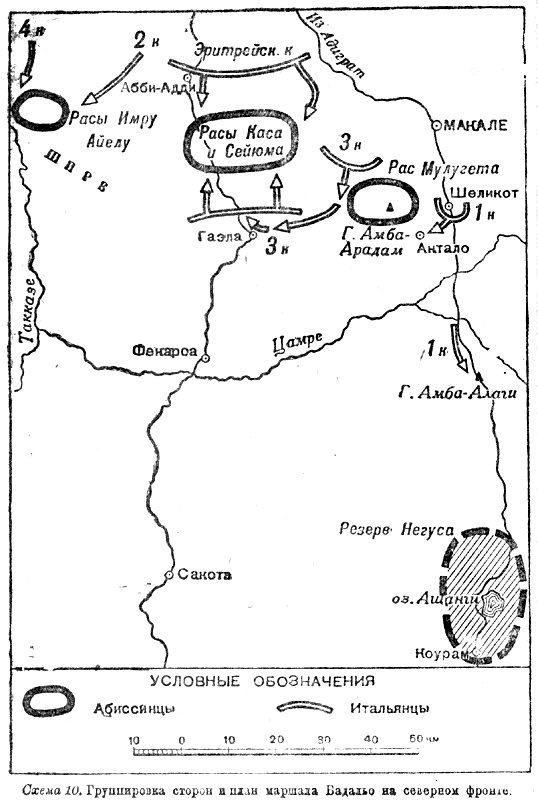
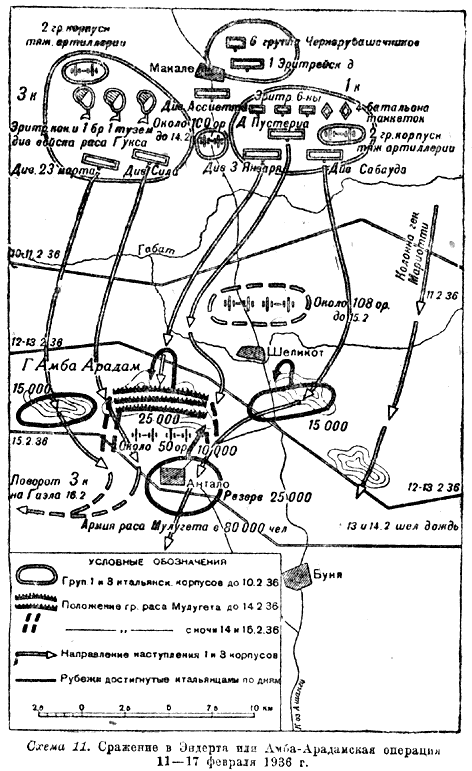
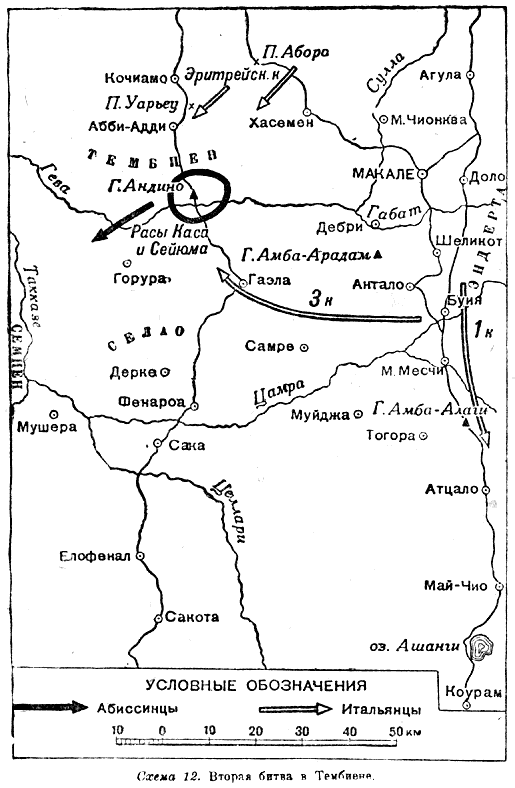
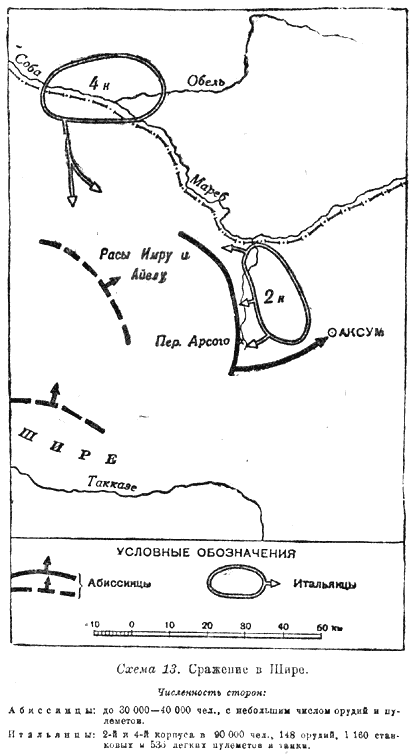
By setting up barriers against the troops of Kas, Seyoum, Imr and Aiel, on February 10 the Italian army attacked the Muluheta forces. Abyssinian troops stood in the Endert region on the Amba-Aradam massif near the Gabat River. The army of Muluheta covered the road to Addis Ababa. The mountain range was pretty well prepared for defense, trenches and shelters were built, so a frontal attack could lead to heavy losses. Abyssinians located on the flanks of the mountain range also prepared for defense.
As a result, a stubborn battle broke out in which the Abyssinians again showed steadfastness and courage in front of the superior forces of the enemy. However, the military-technical superiority of the Italians played a role. Italian troops actively used artillery (up to 108 guns in the central section) and Aviation, widely used smoke screens and chemical weapons. During the 5-day fierce battle, the army of Mulaget was defeated. Ras Mulaget himself died in battle. By February 17, the remnants of the Abyssinian troops were driven back to Amba-Alagi. When retreating, the remnants of the Ethiopian army came under attack from Italian aviation, which finally demoralized the soldiers, many fled.
Thus, as a result of the Amba-Aradam battle, the best army of Ethiopia — the Ras Muluheta — was defeated, the Italians were given freedom in the main line. The Italian army had the opportunity to proceed to the next phase of the operation - the defeat of the army group Kas and Seyouma. The courage and resilience of the Abyssinian warriors was broken by a more advanced army.
The troops of Kasa and Seiyoum, which occupied positions in the mountain range of Andino, due to lack of communication remained unaware that their flank and rear were open to the enemy. In addition, they were sure that they were protected from the rear by impassable mountains. During the defeat of the army of Muluheth, they were inactive. Therefore, Badoglio decided to continue the operation to defeat the enemy. The 1 Corps continued the pursuit of the remnants of the defeated Muluget troops. The Eritrean corps was to attack the enemy from the front, and the 3 corps, after the Amba-Aradam battle, turned to the west, in the direction of Gael. The Italian troops advanced in the inaccessible mountainous terrain and for three days were supplied with the help of aviation. For 11 days, the 3 Corps moved along mountain paths and concentrated in the Gaela area. At the same time, the offensive was launched by the right wing of the Italian army, which was to be taken to the army by Imru and Aiel. The 2 Army Corps attacked the enemy from the front, and the 4 Corps covered the Abyssinians from the north and northwest.
As a result, when the troops of the races Kas and Seiyoum attacked the Italians in Tembiene at the Uaryu pass, they were attacked on February 27-29 by the Eritrean and 3 corps. The Abyssinians tried to break through to the south, and after the failure, they began to retreat to the higher mountainous Semyen region. They were pursued by Italian aircraft, widely sprayed mustard gas. As a result, the troops of Kasa and Seiyoum were demoralized and scattered.
The troops of the races Imru and Aielu, located on the north bank of the river Takkaze, in the Shire region, were aware of the plight of their neighbors and at that time tried to break through to Axum. Their attacks were held back by the 2 Italian Corps. February 29 Italian troops began the third phase of the operation, which included the coverage and destruction of the forces of the princes Imre and Aiel. However, the 4 body was late with the coverage of the left wing of the Abyssinians, which led to serious losses for the 2 body, which at that time attacked from the front. During its march, the 4 corps (as well as the 3 corps) moved through the mountainous terrain and was mainly supplied by aviation. Ras Imru, taking into account the unfavorable situation that has developed for the Ethiopian army, skillfully maneuvering, began to withdraw troops across the river Takkaze. However, here too, the Abyssinians underwent strong attacks by Italian aviation, including chemical weapons, during the crossing. This led to the breakdown of the Abyssinian army. The remaining forces of the race Imru attempted to retreat to Lake Ashangi, where the emperor collected all available troops for the final decisive battle.
Thus, the Italian army under the command of Badollie in three battles defeated and dispersed the main forces of the Abyssinian army. The troops of the races of Muluheta, Kasa and Seiyoum, Imru and Aielu attempted to organize a counter-offensive in the area of Macalla, Tembien, but were defeated and rejected by the Italian army that had begun the offensive, which was reinforced by two corps. The most powerful army of the Ras Muluheta was defeated, and the central direction remained uncovered. The remnants of the Abyssinian armies and reserves were hastily concentrated by the Negus in the area of Lake Ashangi to cover the capital.
Abyssinian soldiers
Battle of Lake Ashangi
After decisive success, the Italian command decided not to stop, pulling back and improving communications, as it had done before, but to continue the offensive with the main forces on Dessie and Addis Ababa in order to consolidate the result. In the meantime, the Ethiopian emperor hastily knocked together an army from the operational reserves and remnants of the army, hoping to organize a counterattack and reject the enemy. At this time, the Italian agents were able to organize in the rear of the Abyssinian army - the Gojam region, an uprising of the supporters of the race Hailu. As a result, the Negus had to divert part of the forces to its suppression, which weakened the troops, who concentrated in the area of Lake Ashangi and the city of Cuoram.
To ensure his offensive from the right wing, Marshal Badoglio sent troops of the 2 and 4 army corps and General Koutura's detachment to Gondar through Semyen. They were to secure the flank of the troops in the main line and prevent the remnants of Imru’s army from connecting with the retreating units of the Seiyoum race. The actions of Kuture and the 4 corps were associated with the newly formed 8-thousand. General Starache’s mechanized column, which moved through Om-Adjer to Gondar through semi-desert terrain. These troops were greatly assisted by aviation, which carried out reconnaissance and ensured the flanks of the troops from the ambushes of the Abyssinian soldiers. 1 April 1936. Italian troops reached Gondar. The troops of the 2 and 4 of the Italian corps crossed at the beginning of March to the river Taccase at Hyde and with their forward detachments reached Gondar and 2 in April united with the column Starace. On April 12, General Kouture’s right-flank column captured Gallabat border with Anglo-Egyptian Sudan and cut the shortest link between Abyssinia and the outside world.
Thus, to the right of the wing of the Italian expeditionary army, without fear of large enemy forces (previously defeated) and advancing on a broad front, occupied a vast territory and forced the Abyssinians to leave the Semyen and Gondar regions. Italians intercepted an important communication leading to Sudan.
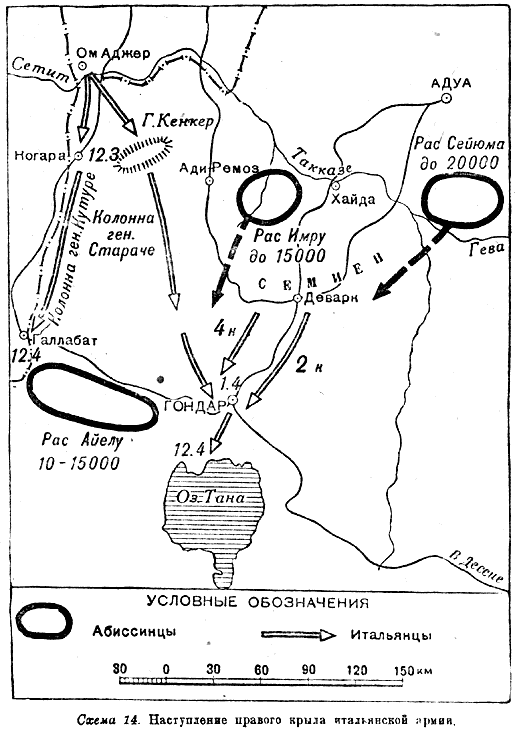
Meanwhile, the main forces of the Italian army were advancing in three directions: the 3 Corps - Gaela-Fenaroa-Sakota-Dessier; 1 and Eritrean Corps - Amba-Alagi-Quoram-Dessier; along the Central Front from Assab, the troops marched through the desert of Danakil to Sardo Dessier. Three attacking Italian corps numbered about 125 thousand people, 210 guns, more than 2400 machine guns, 270 tanks. While the 1 and Eritrean corps were advancing along the main road, the 3 corps was to go to the flank and rear of the Negus army.
Negus concentrated around 40 thousand soldiers from the reserve, various formations and units. On March 21, the emperor, who personally led the troops, decided to launch a counterattack in the Mai-Chio region, north of Lake Ashangi. This decision was caused by the pressure of foreign advisers and some military leaders, as well as the deterioration of the situation in the rear (uprisings, the growth of banditry). The Italians learned about this and managed to prepare: the troops occupied defensive orders in the Mai-Chio region at the front in 10 km, having the 1 corps on the right flank and the Eritrean on the left. Also, the Italians pulled heavy artillery.
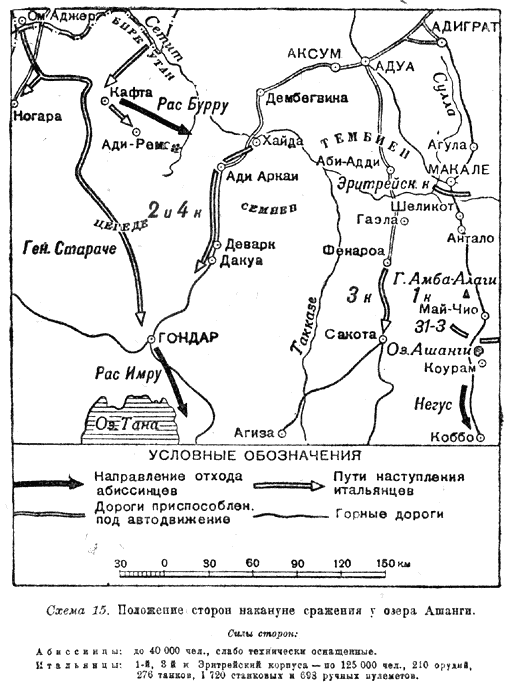
31 March Abyssinian troops went on the attack. The Italians have not yet completed the preparation of defensive lines, so in the beginning a desperate rush of Abyssinians was a success. They pushed the left flank of the enemy. For three days there were stubborn battles, both sides suffered heavy losses. But the Italians, with the help of artillery and aviation, repelled the blow and on April 2 launched a counter-offensive. Broken Abyssinian troops began to retreat. It took place under the continuous strikes of Italian aviation, which widely used chemical weapons. The Eritrean Corps, made a deep bypass of the east and began to threaten the environment. In the rear became active gangs, which were supported by Italian agents. As a result, the army of the emperor ceased to exist as a single force.
In the course of these fierce battles, the Imperial Guard was almost completely killed — the selective core of the Ethiopian army. Negus himself, with a small detachment, hiding from enemy aircraft, was moving toward Addis Ababa at night. After this battle, the Ethiopian army on the Northern Front was practically destroyed as an organized force. Only a few isolated detachments remained, which went over to the partisan struggle. The path to the Abyssinian capital was opened. 20 April Italian troops captured Dessier.
Dessie after aerial bombardment
To be continued ...
- Alexander Samsonov
- Second Italian-Ethiopian War
How Italy conquered Ethiopia
Italian armed forces to the beginning of the invasion of Ethiopia
Ethiopian army to the start of hostilities
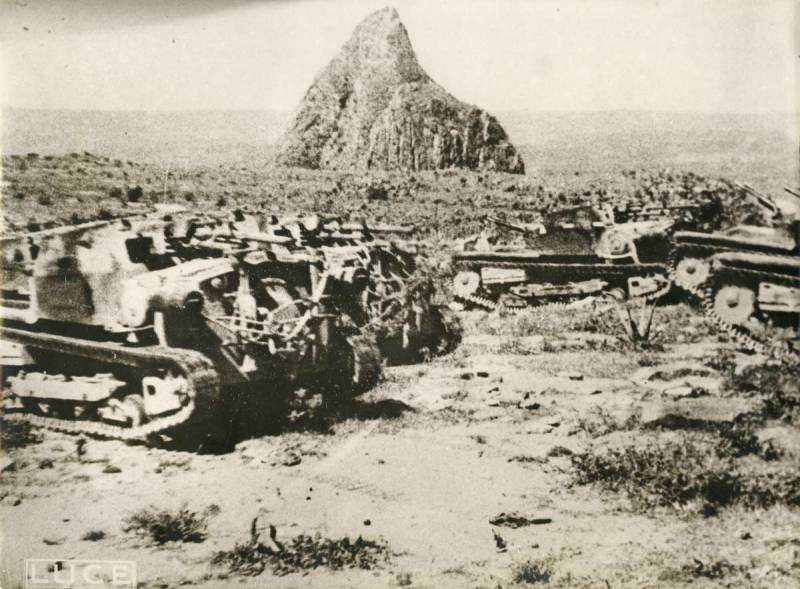
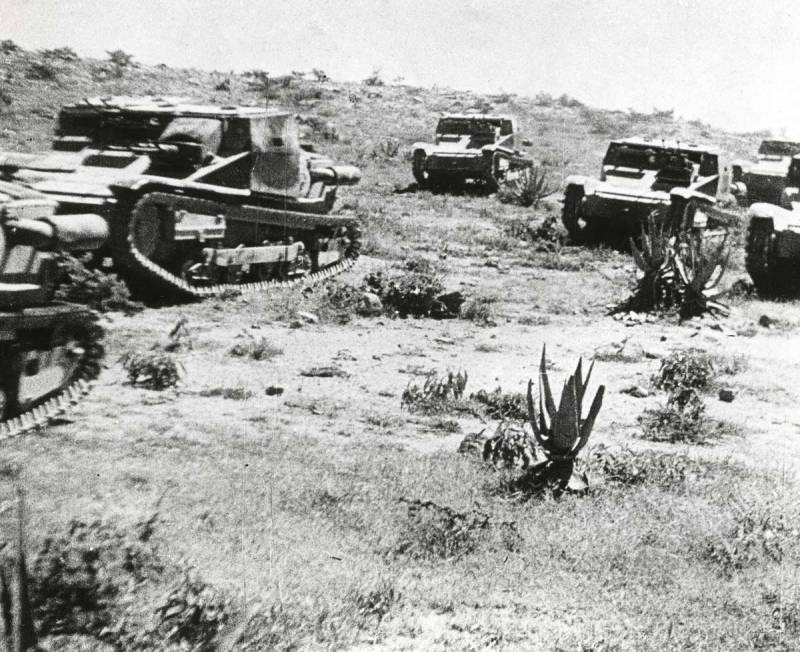
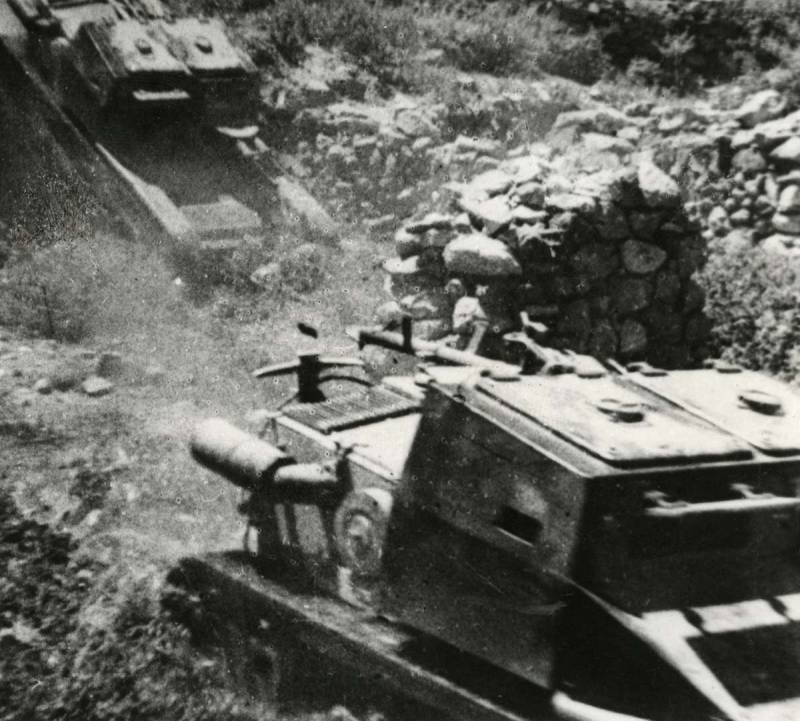
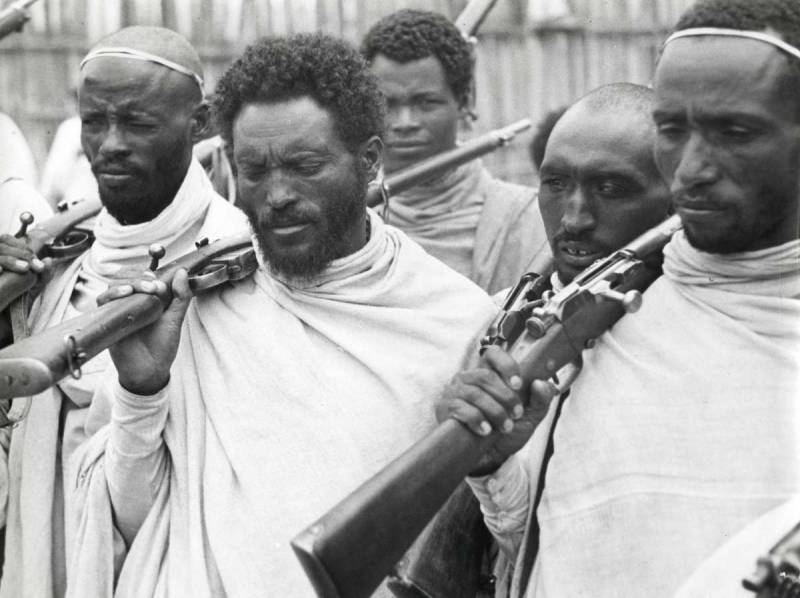
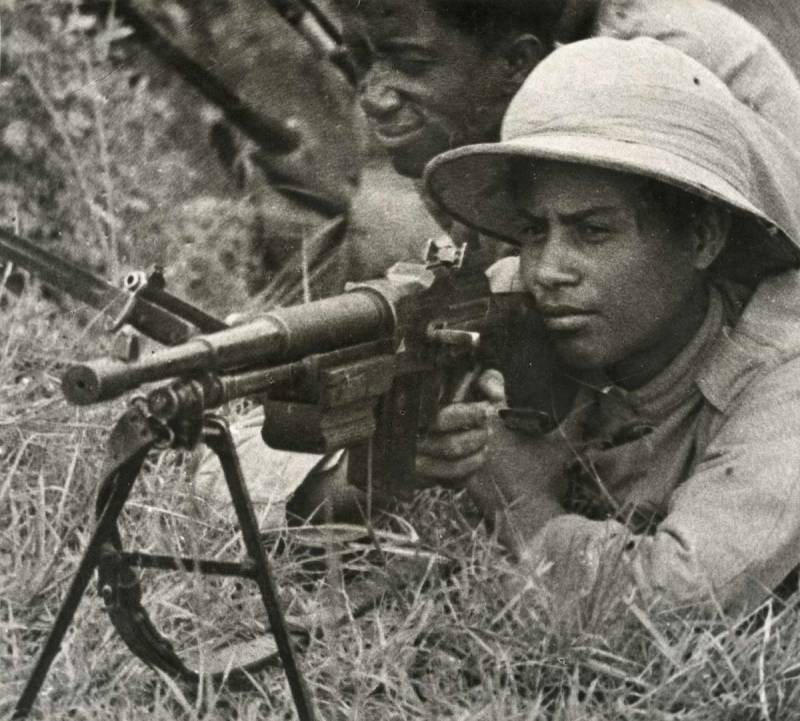
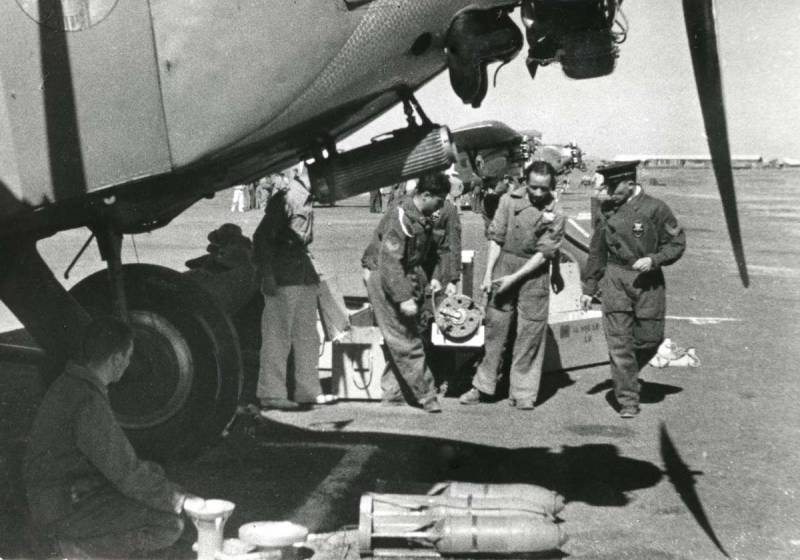
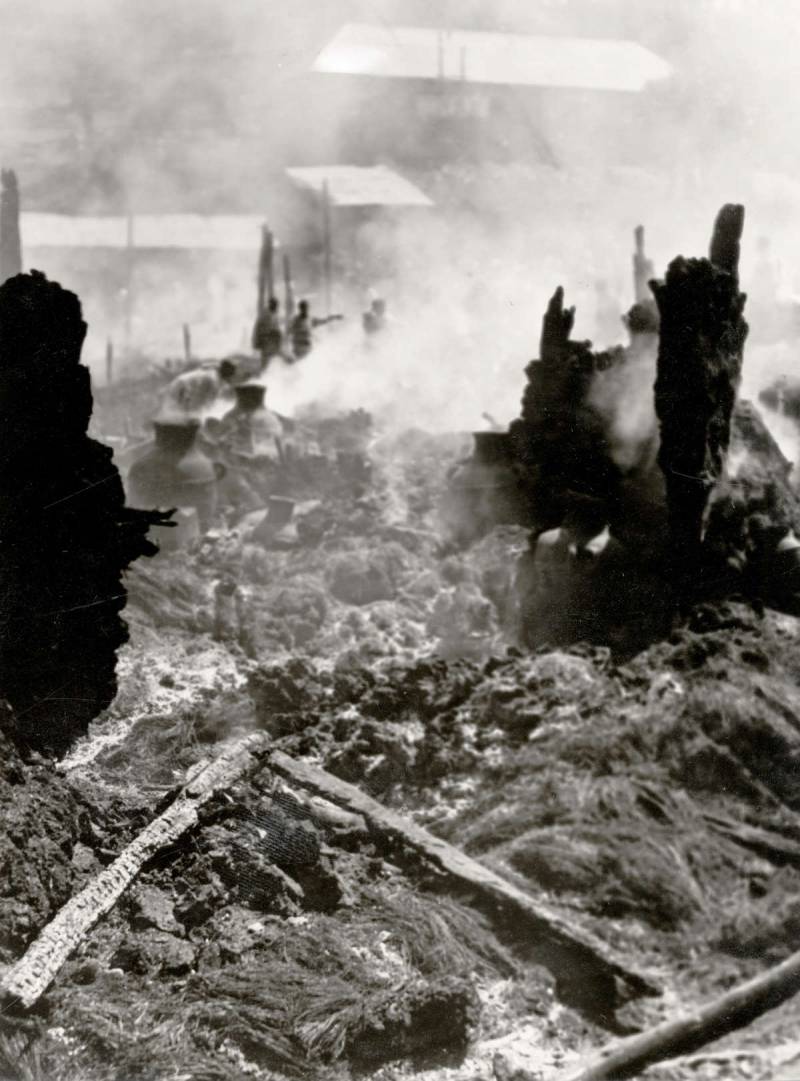
Information